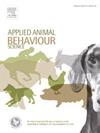Evaluating the personality of dogs involved in animal-assisted interventions and their relationship with the handler: the Italian landscape
IF 2.2
2区 农林科学
Q1 AGRICULTURE, DAIRY & ANIMAL SCIENCE
引用次数: 0
Abstract
Therapy dogs involved in animal-assisted interventions (AAIs) can be a valuable support for individuals with physical or psychological difficulties. The effectiveness of the intervention is influenced by the functioning of the dog-handler dyad. In Italy, handlers who have completed the requisite training are registered on the 'Digital Pet' platform. This study aimed to construct a general profile of the Italian population of therapy dogs and handlers and to investigate the mechanisms underlying the dog-handler relationship. We administered a survey to the handlers registered on Digital Pet. The survey included information on the dyad, an Italian translation of the C/DORS to assess the relationship between the dog and the owner (in this case, the handler), and of the C-BARQ to assess the dog's personality. The data from both questionnaires were subjected to Exploratory Factor Analysis (EFA). Subsequently, factor scores were calculated for each dog-handler dyad and then tested across a series of background variables, including the dog's age, sex, weight, origin, and breed. In conclusion, the correlations between the C-BARQ and C/DORS factors were calculated. A total of 240 respondents were obtained from the 809 handlers who were contacted. EFA identified 14 factors for the C-BARQ and six factors for the C/DORS, which differs from other studies. As expected, the examined cohort of therapy dogs exhibited minimal scores and limited variability for the C-BARQ factors pertaining to behavioral issues, including 'Owner-directed aggression', 'Stranger-directed aggression', and 'Territoriality'. Conversely, the highest median value was observed for the 'Attachment/attention seeking' factor. With regard to the C/DORS, the factor designated 'Perceived costs' exhibited the lowest median scores, while the highest median value was observed for the factor designated 'Perceived emotional closeness – emotional support'. Weak correlations were identified between the factors of the two questionnaires. Moreover, the age and weight of the dog was found to affect some factor scores of both questionnaires. Additionally, specific factors of the C-BARQ were found to be affected by the breed, origin and sex/neuter status of the dog. These preliminary results are part of a multimodal analysis of the dog personality and dog-handler relationship. Further investigation will be conducted through behavioral and hormonal observations, with the aim of elucidating the factors that contribute to the efficacy of AAI teams.
评估参与动物辅助干预的狗的个性及其与训导员的关系:意大利景观
参与动物辅助干预(AAIs)的治疗犬可以为有身体或心理困难的个体提供宝贵的支持。干预的有效性受到训狗者的双重功能的影响。在意大利,完成了必要培训的训导员会在“数字宠物”平台上注册。本研究旨在构建意大利治疗犬和训导员人口的总体概况,并调查狗训导员关系的潜在机制。我们对在Digital Pet上注册的训犬员进行了调查。这项调查包括了二分体的信息,一种意大利语翻译的C/DORS用来评估狗和主人(在这种情况下,指的是训练员)之间的关系,还有一种是C- barq用来评估狗的性格。对两份问卷的数据进行探索性因素分析(EFA)。随后,研究人员计算了每个训狗师组的因素得分,然后在一系列背景变量中进行测试,包括狗的年龄、性别、体重、来源和品种。最后,计算了C- barq与C/DORS因子之间的相关性。在联络的809名处理人员中,共取得240名回应者。EFA确定了C- barq的14个因素和C/DORS的6个因素,这与其他研究不同。正如预期的那样,治疗犬的研究队列在与行为问题相关的C-BARQ因素中表现出最低的分数和有限的变异性,包括“主人导向攻击”、“陌生人导向攻击”和“领土性”。相反,“依恋/注意力寻求”因素的中值最高。就C/DORS而言,“感知成本”因子的中位数得分最低,而“感知情感亲密-情感支持”因子的中位数得分最高。两份问卷的因子之间存在弱相关。此外,狗的年龄和体重被发现会影响两份问卷的一些因素得分。此外,C-BARQ的特定因素被发现受犬的品种,来源和性别/中性状态的影响。这些初步结果是对狗的个性和狗与训导员关系的多模态分析的一部分。进一步的研究将通过行为和激素观察来进行,目的是阐明影响AAI团队疗效的因素。
本文章由计算机程序翻译,如有差异,请以英文原文为准。
求助全文
约1分钟内获得全文
求助全文
来源期刊

Applied Animal Behaviour Science
农林科学-行为科学
CiteScore
4.40
自引率
21.70%
发文量
191
审稿时长
18.1 weeks
期刊介绍:
This journal publishes relevant information on the behaviour of domesticated and utilized animals.
Topics covered include:
-Behaviour of farm, zoo and laboratory animals in relation to animal management and welfare
-Behaviour of companion animals in relation to behavioural problems, for example, in relation to the training of dogs for different purposes, in relation to behavioural problems
-Studies of the behaviour of wild animals when these studies are relevant from an applied perspective, for example in relation to wildlife management, pest management or nature conservation
-Methodological studies within relevant fields
The principal subjects are farm, companion and laboratory animals, including, of course, poultry. The journal also deals with the following animal subjects:
-Those involved in any farming system, e.g. deer, rabbits and fur-bearing animals
-Those in ANY form of confinement, e.g. zoos, safari parks and other forms of display
-Feral animals, and any animal species which impinge on farming operations, e.g. as causes of loss or damage
-Species used for hunting, recreation etc. may also be considered as acceptable subjects in some instances
-Laboratory animals, if the material relates to their behavioural requirements
 求助内容:
求助内容: 应助结果提醒方式:
应助结果提醒方式:


